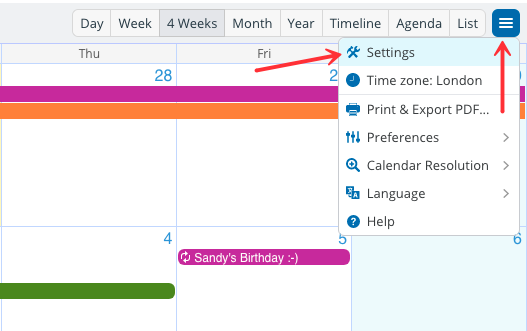In this guide, you will learn about your role as a calendar administrator, how to set up your calendar, how to grant calendar access to others securely, and how to use important calendar features.
Your role as a calendar administrator
The calendar administrator is any authorized person who has administrator access to the calendar. The calendar administrator is responsible for all calendar settings and has full control over the calendar.
- You may be the person who created the calendar.
- Or you may have been given administrator-level access to the calendar.
Learn more about administrator access→
First steps with your Teamup calendar
1: Deciding what sub-calendars to set up
The most important task after creating a calendar is to set up sub-calendars to organize the events you will enter into the calendar. Think carefully about what you want to schedule or organize. While the When aspect of an event will be taken care of by the date and time you choose when you create the event on the calendar, consider setting up a sub-calendar in a unique color to represent the most distinctive entity of who, where, or what of a series of events. For example, setting up Room A as a sub-calendar in red, then all meetings scheduled in Room A will be displayed as red events on the calendar. Visualize all such entities – e.g. all rooms – as sub-calendars and color code each of them. Read more about how to decide what sub-calendars to set up.
Once you have the plan for structuring your calendar, you can begin to set up your calendar in a way that works best for your needs.
2: Access calendar settings
Access calendar settings from the blue menu in the top right of the calendar.
If you do not see Settings in the dropdown menu, you are accessing the calendar without administrator permission. You may be using a shareable calendar link. Open the calendar with your user account (with administrator permission assigned) to access the settings.
Note: you can only access calendar settings in a browser. The full calendar settings are not available on Teamup mobile apps.
Learn more about the calendar settings →
3: Create sub-calendars
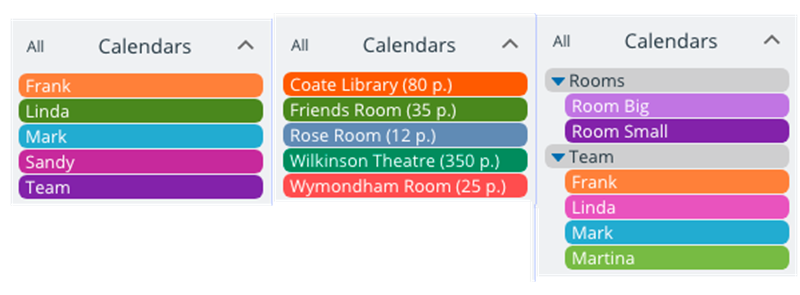
Sub-calendars can represent people, resources, projects, areas, or anything else you need to organize or schedule. Here’s how to create or modify a sub-calendar:
- Go to Settings > Calendars.
- Click on the blue New button and select Add Calendar.
- Enter a title for the new calendar, select a color, and choose to allow or disallow overlapping events.
- Organize calendars in folders by using the > symbol in the calendar name: Main Office > Staff Calendar will create a calendar named Staff Calendar in a folder named Main Office.
Learn more about sub-calendars →
4: Grant calendar access

Establish who needs access to the calendar, and with what permission level.
You can grant access to your Teamup calendar in two ways:
- Account-based users: best for regular calendar access for members of your organization.
- Shareable calendar links: best for temporary calendar access, public/group access, and embedding a calendar.
To grant calendar access:
- Go to Settings > Sharing.
- To add account-based users, choose Add User or Create Group.
- To create a shareable calendar link, choose Create Link.
- Select which calendars to include for each user, group, or link.
- Set the level of access permission for the included calendars.
Learn more about granting calendar access for users, groups, and links →
Configure your Teamup calendar
In the calendar settings, there are several options and defaults you can configure for your needs.
General Settings
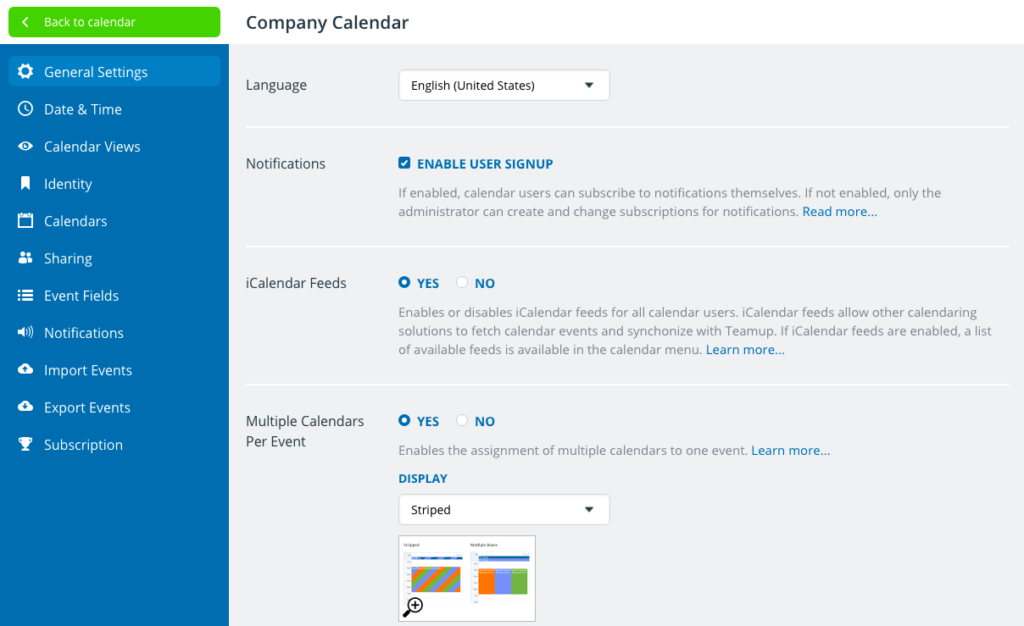
- Teamup supports various languages, with more being added. Choose the default language for your calendar.
- Enable or disable user signup for email notifications.
- Enable or disable iCalendar feeds.
- Enable or disable assigning one event to multiple calendars.
- Enable or disable event sharing, or change which event sharing options are included in the Sharing menu.
- Set preferences for showing or collapsing the sidebar and showing or hiding the date picker.
- Edit the About box for the calendar.
Learn more about the calendar settings →
Date and Time

- Teamup supports time zone conversions for 140+ time zones. Learn more about working with time zones in Teamup.
- Select the applicable date format for your primary user base. The 24-hour clock can be enabled regardless of the common date/time format in your region.
- Select the default start day of the week. Options include Monday, Sunday, Saturday, and Friday.
- Select the visible time range when your calendar is displayed with a time grid. Time slots outside of the time range defined here will still be selectable in the event editor.
- It is possible to set the calendar to always open on a specific date, e.g. a conference date, rather than the current date.
Learn more about time zone support from Teamup →
Calendar views

Choose the calendar view that is most appropriate for your needs. There are 10 calendar views which you can enable or disable in the calendar settings. You can set your preferred calendar view as the default.
- Teamup supports multiple calendar views, including multi-day, multi-week, year, agenda, list, scheduler, and timeline views as well as the usual day, week, and month views.
- The default view set is the view applied when a calendar is loaded in a new browser session. The default view can be overwritten by a link parameter or the user’s last selected view, which is remembered during the same browser session.
- Adjust the time resolution and choose to show or hide weekends.
- The calendar view picker is at the top right of the calendar.
- You can toggle calendar views on and off in the calendar settings; if toggled off, the view will no longer be available in the calendar view picker.
- Set defaults for calendar views, such as number of days to show in multi-day view.
- Choose whether to display event details by default in List and Agenda views.
Learn more about calendar views →
Identity

- Change the calendar title, if desired.
- You can upload your own logo.
- You can customize the header colors (background and font).
Learn more about customizing your calendar identity →
Calendars
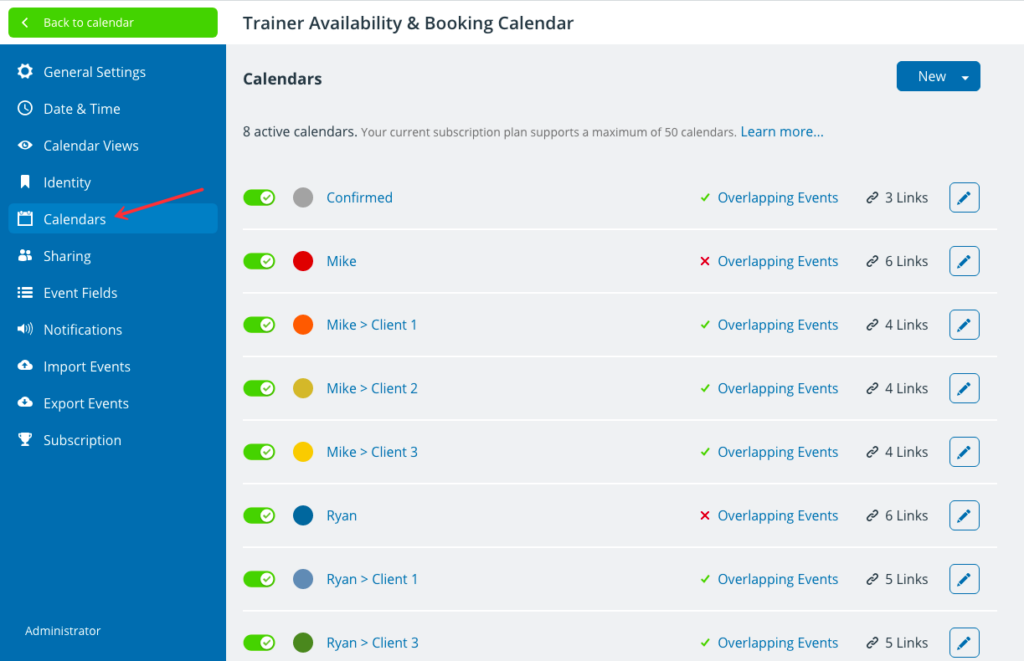
- There are a million ways to use Teamup Calendar. The essential decision to make as calendar administrator is what and how you want to organize or schedule, then translate that into your calendar structure.
- You can use live demos to test out various scenarios.
- Events assigned to a specific sub-calendar will be displayed in the color of that calendar.
- Prevent double bookings by choosing to disallow overlapping events on your calendars.
- Group sub-calendars into folders for easy organization.
- The number of active sub-calendars you may have is linked to your subscription plan. You can upgrade any time to use more sub-calendars.
- If you have more than 12 sub-calendars, you can filter by keyword.
Learn more about color-coded sub-calendars →
Sharing
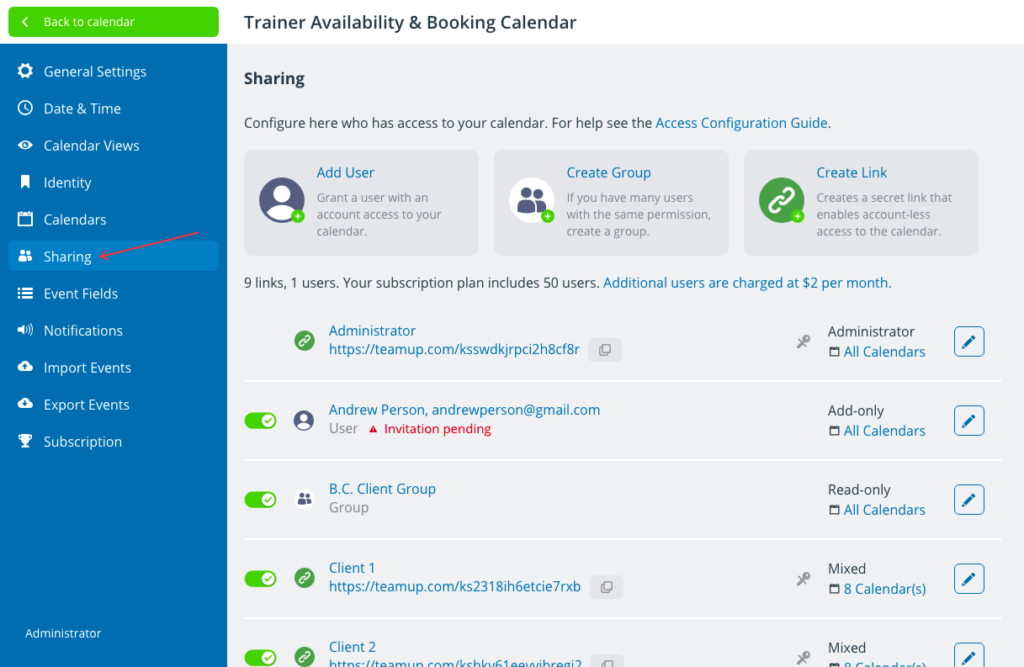
- Calendar access is granted to account-based users or with shareable calendar links.
- There are 9 levels of access permission, including the unique add-only and modify-from-same permission.
- Customize access to each sub-calendar by assigning granular access permissions for each user or link.
- You can create groups for account-based users for easier user management.
- Name the shareable link clearly so you can identify what it is being used for and who has access to the link.
- You can deactivate or delete a shareable link at anytime.
- The number of account-based users you may have is linked to your subscription plan. You can upgrade any time to add more account-based users.
- The Basic and Plus plans allow up to 50 shareable calendar links. Premium and Enterprise plans allow unlimited shareable calendar links.
Learn more about sharing your calendar with users, groups, and links →
Event fields
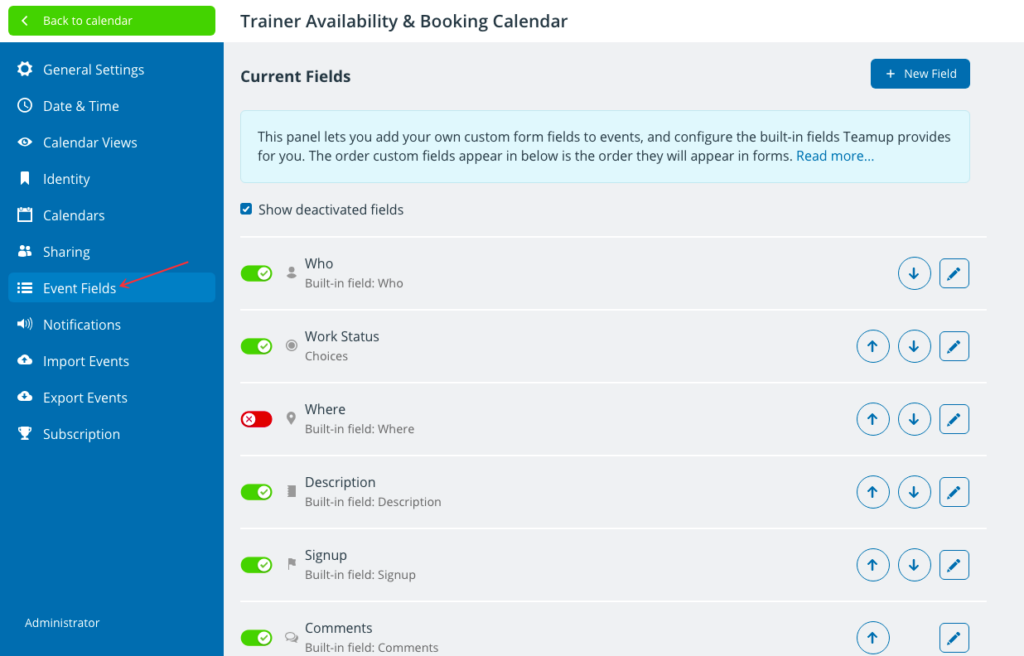
- Each Teamup calendar has certain default event fields, including Who, Where, Description, Signup, and Comments.
- You can rearrange these default event fields and toggle them on or off.
- Custom event fields allow you to create your own unique event fields for your calendar.
- Custom event fields can be single-line text entry or can have options for single or multiple choice.
- You can choose to show the contents of a custom event field in the event title.
- The number of custom event fields you may have is linked to your subscription plan. You can upgrade any time to add more custom event fields.
Learn more about event fields →
Notifications

- Teamup calendar supports email notifications, a daily agenda, and Slack integration for calendar notifications in a Slack channel.
- If user signup for notifications is enabled (in General Settings), account-based users will be able to add or modify their own notification subscriptions.
- The calendar administrator can always see an overview of existing notifications, and can add, edit, or remove notifications as needed.
- Because notification emails contain the link that was used to set up the notification subscription, it is important to NEVER set up notifications from an administrator link (unless the user is indeed an administrator).
Learn more about Teamup notifications →
Import Events

- You can import calendar data from other calendar applications, spreadsheets, databases and text fields.
- Currently supported import formats are iCalendar files (#.ics) and text files with comma-separated values (*.csv).
- You can also import data from one Teamup Calendar to another.
- Only the calendar administrator can import files.
Learn more about importing events to Teamup calendar →
Export Events
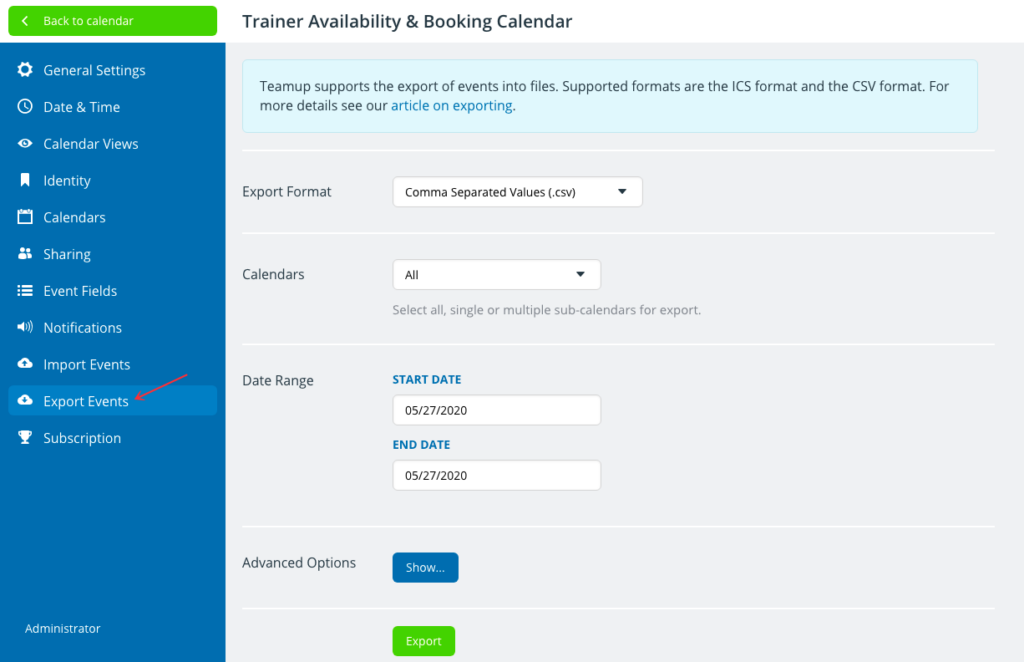
- You can bulk export calendar data from your Teamup Calendar to text files with comma-separated values (.csv) or iCalendar files (.ics).
- It is possible to choose to export events from a specific sub-calendar or all calendars.
- If you would like to analyze or generate reports with your data, it is best to bulk export the data to the .csv file format, open it locally and display it on an Excel sheet, then conduct the analysis as you need.
- You can also export event signups and event comments in the .csv file format.
- Only the calendar administrator can bulk export.
Learn more about exporting events from Teamup calendar →
Subscription

- There are four subscription plans available for Teamup Calendar: Basic (free), Plus, Premium, and Enterprise.
- To test Teamup Plus or Premium features before purchasing an upgrade, start a free trial calendar or use a live demo calendar.
- When you are ready to upgrade to a different plan, simply click the relevant upgrade button and complete the payment.
- As soon as the payment is successfully completed, the upgrade takes place automatically.
- If you see ‘Payment pending’ in your Subscription History, your payment did not go through. Contact your bank to identify the issue. If the problem persists, see here or contact support@teamup.com.

